![]()
|
xtreview is your : Video card - cpu - memory - Hard drive - power supply unit source |
|
|
|
|
||
|
POSTER: computer news || THE INITIATIVE OF NVIDIA MAX-Q WILL ALLOW ULTRA-THIN GAMING LAPTOPS TO APPEAR |
DATE:2017-05-30 |
|
On NVIDIA site appeared the news about the initiative of Q-Max, which will contribute to the appearance in the market of ultrathin gaming laptops of a new generation. Of course, the term "hyperfine" here needs to be applied with an eye on the overall dimensions of gaming laptops of previous generations, the absolute leadership is not claimed by the new family. 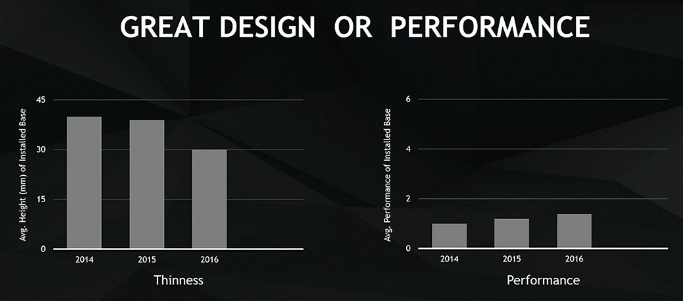 The history of the development of gaming laptops, according to the head of the company, always meant the choice between a small thickness of the case and high speed. To obtain both, both simultaneously it was possible only with considerable reservations. 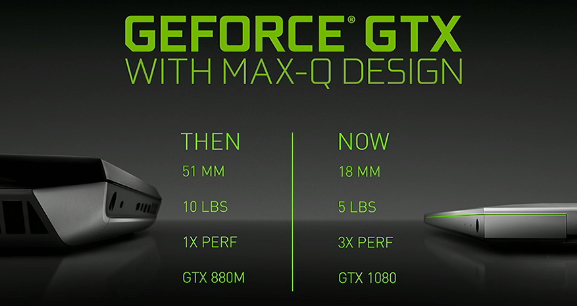 The Max-Q initiative, created within the framework of which gaming laptops will appear on the market since June 27 this year, implies optimization of performance in order to reduce the size and weight. The thickness of the case can be reduced to 18 mm, and the mass of the gaming laptop hardly exceeds 2 kg. At the same time, there will be a mobile version of the discrete graphics solution GeForce GTX 1080 inside. At the opening of Computex 2017, Asus gaming laptop created on these canons was demonstrated (pictured right). 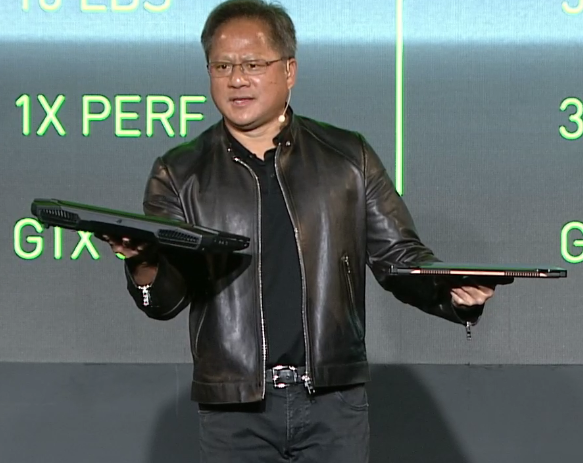 According to the speaker, this notebook Asus is 60% faster than the Sony PlayStation 4 Pro game console, while it is equipped with a TV tuner. As explained by NVIDIA, optimization within the Max-Q initiative implies choosing the most beneficial settings in each particular game, using the most advanced cooling systems and flexible power management. In other words, a lot depends on the software component. The company had to work with drivers.  The initiative of NVIDIA Max-Q will allow ultra-thin gaming laptops to appear |
Add Comment ( 1 ) THE INITIATIVE OF NVIDIA MAX-Q WILL ALLOW ULTRA-THIN GAMING LAPTOPS TO APPEAR |
|
|
|
|
POSTER: computer news || THE NEW ARM CORES HAVE GOT THE BEGINNINGS OF ARTIFICIAL INTELLIGENCE |
DATE:2017-05-30 |
|
Yesterday ARM company, absorbed by Japanese company SoftBank from autumn of last year, presented two new computing cores (Cortex-A75 and Cortex-A55) and one graphics core (Mali G72). A distinctive feature of the new products was the support of technology DynamIQ and a new set of instructions ARMv 8.2. DynamIQ technology was introduced in March . 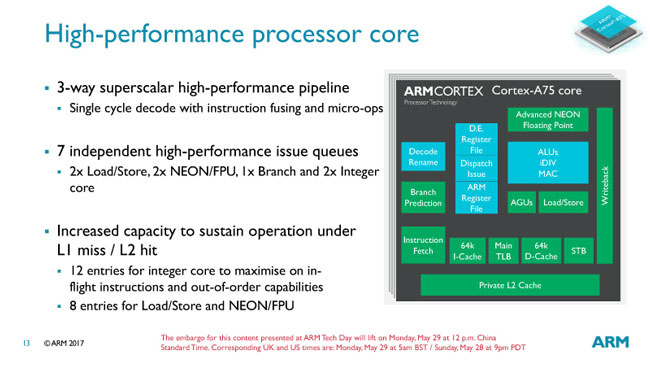 Let's remind, DynamIQ became evolutionary development of technology big.LITTLE. So, if big.LITTLE allowed to create bundles of two clusters with different cores (up to 4 cores in each cluster), DynamIQ makes it possible to create one cluster of eight different cores, where each of them can have its own power level and its own Clock speed, as well as perform their tasks. Such an approach will allow creating highly optimized solutions. There have also been changes in the architecture of the cache. Now each core has an individual L1 and L2 cache, and they all have access to the shared L3 cache. Previous ARM kernels carried L1 cache and shared L2. 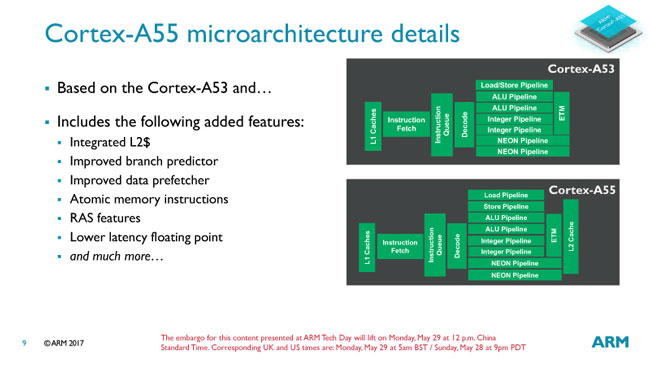 As for the extended set of instructions, most of them are sharpened for processing tasks that can be attributed to the work of artificial intelligence. According to the developers, in due course AI should appear in "every iron", and not work somewhere in the cloud. This is the only way to ensure the daily accessibility of the masses to useful and even irreplaceable functions. In general, according to the calculations of the current owner of ARM company - SoftBank, by 2035 the ARM cores will be exclusively in all things with an Internet connection. 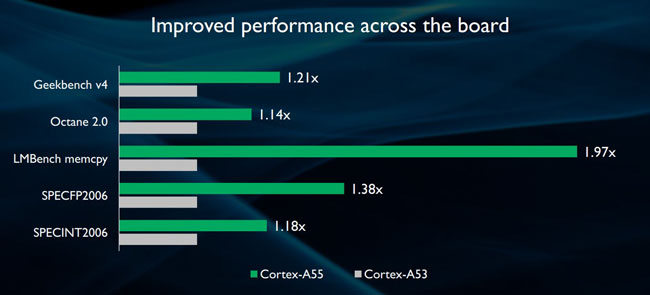 The new high-performance cores Cortex-A75 introduced yesterday are oriented to the whole range of tasks. There is no more breakdown for mobile and server cores. A new development will appear in both smartphones and servers. In comparison with the Cortex-A73 cores, the performance of a single stream on the Cortex-A75 cores has grown to 20% (mobile processors). When compared with the server cores Cortex-A72, the performance of a single thread increased to 40%. All this for a single technical process and for an equal clock frequency. 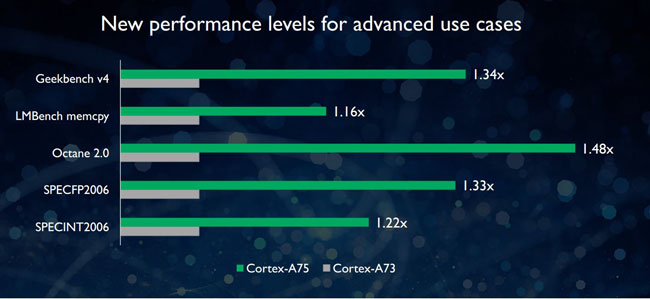 The performance of processing a single stream on the Cortex-A55 cores has increased in comparison with the Cortex-A53 cores and even more - almost twice. At the same time, the consumption of new kernels decreased by 15%. Thanks to DynamIQ technology, it was possible to assemble 8 Cortex-A55 cores in one cluster, which would simply "tear" the middle segment, which was previously dominated by a bundle of 4 Cortex-A53 cores. 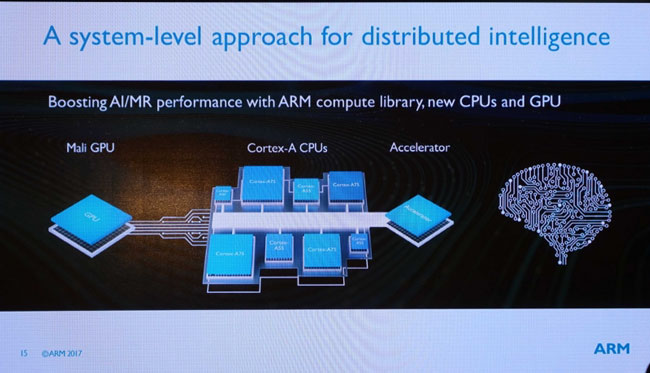 According to the graphical kernels Mali G72, information is not enough. It is assumed that they are only slightly modified core of Mali G71. Select Rating :The new ARM cores have got the beginnings of artificial intelligence |
Add Comment ( 1 ) THE NEW ARM CORES HAVE GOT THE BEGINNINGS OF ARTIFICIAL INTELLIGENCE |
|
|
|
|
POSTER: computer news || BACK SIDE OF NVIDIA TESLA V100 |
DATE:2017-05-30 |
|
A lot of attention on the speech of NVIDIA head , dedicated to the opening of the exhibition Computex 2017, was given to calculations acceleration . In fact, it was in this context that the event mentioned the Volta generation accelerators. It was announced that the partners of the company for the production of server systems HGX-1 are concentrated in Taiwan: they are Foxconn, Inventec, Quanta and Wistron.  In one such system it is possible to combine up to eight Tesla P100 or Tesla V100 accelerators, which will be reported via the NVLink interface, and will provide performance at the level of one petaflops. These accelerators will be connected to the motherboard via the SMX connector, which we will discuss below.  Once again, the characteristics of NVIDIA GV100 - the largest processor in the world, were mentioned, according to the head of NVIDIA. The development of this processor was conducted for three years, and cost the company a decent amount. Actually, it is the crystal size and the amount of cheap memory such as HBM2 that allow us to assume that this kind of graphics processor will not exactly appear in gaming graphics cards.  The Tesla V100 module in SXM version was demonstrated not only on sketches, but also alive - the head of the company held it in his hands, as at the previous event. 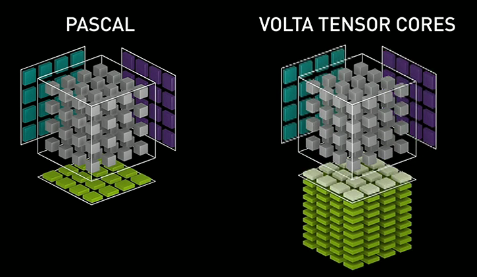 It was said that due to the use of new cores for tensor computations, Volta processors provide a 12-fold advantage in arithmetic speed in comparison with Pascal.  Finally, the "dark side of Volta" appeared in front of camera lenses:  The Tesla P100 computation accelerators of the Pascal generation also have a similar design, which allows them to provide compatibility with HGX-1 systems. Select Rating :back side of NVIDIA Tesla V100 |
Add Comment ( 1 ) BACK SIDE OF NVIDIA TESLA V100 |
|
|
|
|
POSTER: computer news || ISAAC LAB: NVIDIA OFFERS TO TRAIN ROBOTS IN VIRTUAL SIMULATORS |
DATE:2017-05-30 |
|
A significant part of NVIDIA founder report at the opening of Computex 2017 was devoted to the development of robotics and the participation of this company in this process. For this industry, NVIDIA has several promising solutions at once, and it's not just about hardware. To begin with, NVIDIA is ready to offer customers a "cloud development environment", which by placing the main tools in one container allows you to move from the use of workstations to the server infrastructure as the project is scaled. The NVIDIA GPU CLOUD platform will be available for beta testing from July this year.  Secondly, Holodeck's virtual visualization environment will allow NVIDIA customers not only to participate in the collective study of three-dimensional digital prototypes (like an electric scooter in an illustration, viewed by three specialists), but also create entire production enterprises in this simulated environment.  In the near future, robots will be actively used not only on the conveyor belt, but also in agriculture, logistics, monitoring of the state of infrastructure facilities, as well as for care of the elderly and even in the field of surgical operations. According to the head of NVIDIA, robots can work in the human body more accurately and delicately than the surgeon's hand with a scalpel.  Initiative Isaac Lab, named in honor of the famous science fiction writer Isaac Asimov, implies the creation of a virtual incubator for training robots for certain operations. Conducting training in the real world is not always safe, and it's expensive. The virtual environment, in addition, allows you to accelerate the course of time and learning itself.  As an example of such a learning environment, NVIDIA demonstrated a virtual robot model that mastered the principles of the game of hockey. 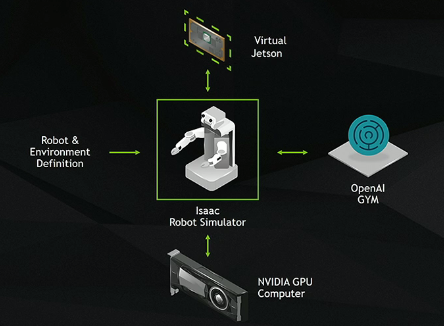 The software used allowed the robot to independently understand the principles of interaction with sports equipment, as well as to improve the skills of handling them.  In a virtual environment, parallel learning can be done immediately for several prototypes. Developers select "the most capable", generalize all the accompanying experience, and then endow all serial products with this set of knowledge. By the way, the head of NVIDIA at the beginning of the profile session of the report ironically noted that the creation of a car with an autopilot is in this sense quite a simple task. You just need to order the "robot" to follow from point A to point B, and at the same time do not crash into anything. In cases where robot functions involve contact interaction with objects, training will require much more time. Select Rating :Isaac Lab: NVIDIA offers to train robots in virtual simulators |
Add Comment ( 1 ) ISAAC LAB: NVIDIA OFFERS TO TRAIN ROBOTS IN VIRTUAL SIMULATORS |
|
|
|
|
xtreview is your : Video card - cpu - memory - Hard drive - power supply unit source |
|
|
|
|
||
![]()
To figure out your best laptops .Welcome to XTreview.com. Here u can find a complete computer hardware guide and laptop rating .More than 500 reviews of modern PC to understand the basic architecture


7600gt review
7600gt is the middle card range.
We already benchmarked this video card and found that ...

 geforce 8800gtx and 8800gts
geforce 8800gtx and 8800gts  Xtreview software download Section
Xtreview software download Section  AMD TURION 64 X2 REVIEW
AMD TURION 64 X2 REVIEW  INTEL PENTIUM D 920 , INTEL PENTIUM D 930
INTEL PENTIUM D 920 , INTEL PENTIUM D 930  6800XT REVIEW
6800XT REVIEW  computer hardware REVIEW
computer hardware REVIEW  INTEL CONROE CORE DUO 2 REVIEW VS AMD AM2
INTEL CONROE CORE DUO 2 REVIEW VS AMD AM2  INTEL PENTIUM D 805 INTEL D805
INTEL PENTIUM D 805 INTEL D805  Free desktop wallpaper
Free desktop wallpaper  online fighting game
online fighting game  Xtreview price comparison center
Xtreview price comparison center 

- 233 - E8600 vs q9400 which is better dual or quad core
Date : 2008-11-21
- 216 - Intel core 2 duo e6550 review and overclocking
Date : 2007-08-03
- 212 - Intel core 2 extreme qx6850 and core 2 duo e6850 review benchmark and overclocking
Date : 2007-07-16
- 205 - Amd athlon x2 be review , overclocking and energy consumption test
Date : 2007-06-05
- 229 - Radeon hd 4670 vs geforce 9500 gt vs geforce 9800 gt vs hd 4850 overclock benchmark and review
Date : 2008-10-10
- 228 - Crossfire hd 4870 x2 vs crossfire hd 4870 review and benchamrk
Date : 2008-09-26
- 226 - Amd radeon hd 4870 x2 2x1gb xtreview exclusive review
Date : 2008-07-14
- 220 - Nvidia 9600 gt review and benchmark
Date : 2008-02-27
- 131 - 500 to 750 gig hdd round up : maxtor wd seagate hitachi
Date : 2006-07-10
- 65 - Raptor x hdd western digital review overview : pcmark - benchmark - test
Date : 2006-05-06
- 193 - Asus s6fm-1p039e vs sony vaio vgn-g11xn/b vs lenovo 3000 v100 review and benchmark
Date : 2007-05-11
- 172 - Apple imac 20 inch - intel core 2 duo review
Date : 2007-01-26
- 102 - Toshiba tecra a6-s513 review notebook performance benchmark
Date : 2006-06-09
- 101 - Sony vgn-fj1sr review notebook performance benchmark
Date : 2006-06-09
SnagIt v.9.1.22009-04-24
Daemon Tool v.4.30.42009-04-24
WinSCP v.4.1.92009-04-24
Vista Codec Package v.5.2.02009-04-24
Vista Codec x64 Components v.1.8.12009-04-24
Anti-keylogger v.9.2.12009-04-24
Portable Firefox v.3.0.92009-04-24
AVG Internet Security v.8.5.322a14952009-04-24
Universal Viewver v.4.0.02009-04-24
Wise Disk Cleaner v.4.242009-04-24
FeedDemon v.3.0.0.16 Beta2009-04-24
SiSoft Sandra 2009 SP2 (2009.5.15.96)2009-04-24
Atheros AR5xxx Driver v.7.7.0.2332009-04-24
Bios update for 24 April2009-04-24
AIMP Classic v.2.60 Build 466 Beta 12009-04-23
SpeedFan v.4.382009-04-23
- The new version of GPU-Z finally kills the belief in the miracle of Vega transformation
- The motherboard manufacturer confirms the characteristics of the processors Coffee Lake
- We are looking for copper coolers on NVIDIA Volta computing accelerators
- Unofficially about Intels plans to release 300-series chipset
- The Japanese representation of AMD offered monetary compensation to the first buyers of Ryzen Threadripper
- This year will not be released more than 45 million motherboards
- TSMC denies the presentation of charges from the antimonopoly authorities
- Radeon RX Vega 64 at frequencies 1802-1000 MHz updated the record GPUPI 1B
- AMD itself would like to believe that mobile processors Ryzen have already been released
- AMD Vega 20 will find application in accelerating computations
- Pre-orders for new iPhone start next week
- Radeon RX Vega 57, 58 and 59: the wonders of transformation
- ASML starts commercial delivery of EUV-scanners
- The older Skylake processors with a free multiplier are removed from production
- Meizu will release Android-smartphone based on Helio P40
- AMD Bristol Ridge processors are also available in American retail
- The fate of Toshiba Memory can be solved to the next environment
- duo GeForce GTX 1080 Ti in GPUPI 1B at frequencies of 2480-10320 MHz
- New Kentsfield overclocking record up to 5204 MHz
- Lenovo released Android-smartphone K8
Affiliates



computer news computer parts review OLD Forum Downloads New Forum Login Join Articles terms Hardware blog Sitemap myspace proxy Get Freebies







